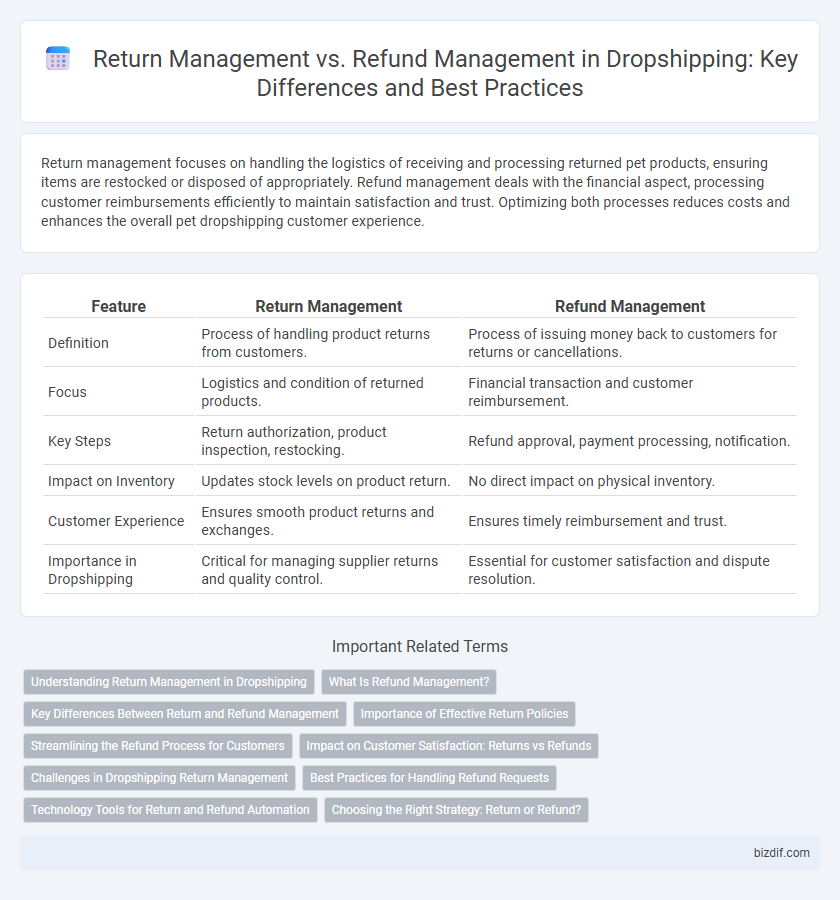Return management focuses on handling the logistics of receiving and processing returned pet products, ensuring items are restocked or disposed of appropriately. Refund management deals with the financial aspect, processing customer reimbursements efficiently to maintain satisfaction and trust. Optimizing both processes reduces costs and enhances the overall pet dropshipping customer experience.
Table of Comparison
| Feature | Return Management | Refund Management |
|---|---|---|
| Definition | Process of handling product returns from customers. | Process of issuing money back to customers for returns or cancellations. |
| Focus | Logistics and condition of returned products. | Financial transaction and customer reimbursement. |
| Key Steps | Return authorization, product inspection, restocking. | Refund approval, payment processing, notification. |
| Impact on Inventory | Updates stock levels on product return. | No direct impact on physical inventory. |
| Customer Experience | Ensures smooth product returns and exchanges. | Ensures timely reimbursement and trust. |
| Importance in Dropshipping | Critical for managing supplier returns and quality control. | Essential for customer satisfaction and dispute resolution. |
Understanding Return Management in Dropshipping
Return Management in dropshipping involves handling the logistics and customer service related to product returns, ensuring seamless communication between suppliers and buyers. Efficient return management processes reduce operational costs and enhance customer satisfaction by streamlining reverse logistics and inventory updates. Differentiating return management from refund management is critical, as returns focus on product recovery while refunds address financial reimbursement.
What Is Refund Management?
Refund management in dropshipping refers to the systematic process of handling customer refund requests by verifying purchase details, assessing return eligibility, and processing reimbursements efficiently to maintain customer satisfaction and trust. This process includes tracking refund status, updating inventory records, and ensuring compliance with store policies and payment platform regulations. Effective refund management reduces chargebacks and negative reviews, directly impacting store profitability and operational efficiency.
Key Differences Between Return and Refund Management
Return management involves handling the process of customers sending back products due to defects, dissatisfaction, or exchange requests, focusing on logistics, inspection, and restocking. Refund management centers on reimbursing customers financially after returns or cancellations, emphasizing payment processing and transaction accuracy. The key difference lies in return management dealing primarily with physical product flow, while refund management addresses the financial transactions associated with returns.
Importance of Effective Return Policies
Effective return policies are crucial in dropshipping to enhance customer satisfaction and reduce operational costs associated with returns. Clear differentiation between return management--handling the logistics of product returns--and refund management--the process of reimbursing customers--ensures streamlined workflows and faster resolution times. Optimizing these policies minimizes disputes and builds trust, ultimately increasing repeat purchases and brand loyalty.
Streamlining the Refund Process for Customers
Return management focuses on handling the logistics of product returns, including shipping and inventory updates, while refund management concentrates on processing the customer's payment reimbursement efficiently. Streamlining the refund process for customers involves automating refund approvals and issuing payments promptly to enhance satisfaction and reduce operational delays. Integrating refund management systems with order tracking and inventory control ensures a seamless experience that minimizes disputes and fosters trust in dropshipping businesses.
Impact on Customer Satisfaction: Returns vs Refunds
Effective return management enhances customer satisfaction by providing a seamless process for product exchanges or replacements, reducing frustration and increasing brand loyalty in dropshipping. Refund management directly impacts customer trust and confidence by ensuring timely and accurate monetary reimbursements following returns or order cancellations. Balancing both strategies minimizes negative reviews and fosters repeat purchases, essential for maintaining a competitive edge in the dropshipping market.
Challenges in Dropshipping Return Management
Dropshipping return management faces significant challenges such as coordinating returns across multiple suppliers and shipping carriers, leading to extended processing times and higher costs. Managing inconsistent return policies and communication gaps between sellers, suppliers, and customers complicates the resolution process. Efficient return tracking and ensuring product condition upon return remain critical hurdles impacting customer satisfaction and operational efficiency.
Best Practices for Handling Refund Requests
Efficient return management in dropshipping involves clear policies, streamlined communication, and timely inspection of returned products to minimize shipping costs and prevent fraud. Best practices for handling refund requests emphasize prompt approval of eligible refunds, use of automated systems for tracking, and maintaining transparent customer service to enhance trust and retention. Integrating a robust return and refund workflow optimizes customer satisfaction and operational efficiency.
Technology Tools for Return and Refund Automation
Technology tools for return and refund automation streamline dropshipping operations by integrating real-time tracking, automated communication, and inventory updates. Return management software focuses on processing return requests, generating shipping labels, and managing product conditions, while refund management tools automate payment reversals, track refund statuses, and handle customer notifications seamlessly. Leveraging platforms like AfterShip, Returnly, and Re:amaze boosts efficiency, reduces manual errors, and enhances customer satisfaction in dropshipping return and refund workflows.
Choosing the Right Strategy: Return or Refund?
Choosing the right strategy between return management and refund management in dropshipping depends on customer experience priorities and operational costs. Return management helps maintain product value and allows quality control but involves logistics and restocking expenses, while refund management offers faster resolution and higher customer satisfaction at the cost of product loss. Analyzing return rates, product types, and profit margins guides selecting the optimal approach for reducing losses and enhancing brand reputation.
Return Management vs Refund Management Infographic

 bizdif.com
bizdif.com